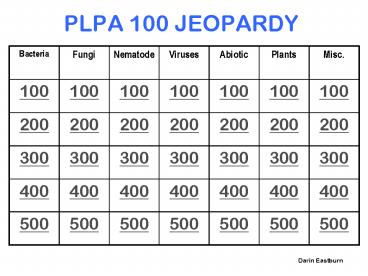PLPA 100 JEOPARDY - PowerPoint PPT Presentation
1 / 36
Title:
PLPA 100 JEOPARDY
Description:
A common method of overwintering and dissemination used by many plant pathogenic ... What is ELISA? Most plant viruses have this type of nucleic acid. What is RNA? ... – PowerPoint PPT presentation
Number of Views:50
Avg rating:3.0/5.0
Title: PLPA 100 JEOPARDY
1
PLPA 100 JEOPARDY
Darin Eastburn
2
The most common sign of a bacterial infection of
plants
- What is bacterial ooze?
3
The method bacterial use to multiply
- What is binary fission?
4
Most plant pathogenic bacteria belong to this
group (shape, etc.)
- What are gram negative rods?
5
A common method of overwintering and
dissemination used by many plant pathogenic
bacteria
- What is seed transmission?
6
The bacterial pathogen that causes fire blight of
apples and pears
- What is Ewinia amylovora?
7
Claviceps purpurea, the cause of ergot of rye,
overwinters as this fungal structure
- What is a sclerotium?
8
A rust life cycle that involves two different
host plants
- What is heteroecious?
9
The type of hyphae, found in Oomycetes, which
lacks any cross walls or septations
- What is coenocytic hyphae?
10
These three control strategies are used to help
manage Dutch elm disease
- What are sanitation, fungicides, and host
resistance, (or biocontrol)?
11
The two species of fungi that can cause Dutch elm
disease
- What are Ophiostoma ulmi and O. novo-ulmi ?
12
Most plant parasitic nematodes feed on these
plant parts
- What are roots?
13
The soybean cyst nematode it believed to
originate in this part of the world
- What is Asia?
14
All plant parasitic nematodes and plant viruses
are in this group
- What are obligate parasites?
15
Two common symptoms of infection by root
colonizing nematodes
- What are yellowing and stunting?
16
A plant parasitic nematode that continues to move
within the plants tissue to find new feeding sites
- What is a migratory, endoparasite?
17
The most common insect vectors of plant viruses
- What are aphids?
18
The term commonly used for the process of virus
reproduction
- What is replication?
19
The most widely used method for detecting plant
viruses
- What is ELISA?
20
Most plant viruses have this type of nucleic acid
- What is RNA?
21
Three characteristics that distinguish persistant
and non-persistant forms of virus transmission
- What are acquisition, transmission, and
retentions times?
22
This soil property affects the amount and type of
nutrients available to plants
- What is soil pH?
23
These two air pollutants undergo chemical
reactions in the atmosphere and produce acid rain
- What are SO2 and NOX?
24
A change in plant health or normal function as a
result of an instantaneous interaction with an
external factor
- What is an injury?
25
Three ways that herbicide injury can occur
- What are tank contamination, drift, and carry
over ?
26
Three characteristics of abiotic diseases that
can help distinguish them from biotic disease
- What are affecting multiple species, uniform
appearance, and patterns of distribution ?
27
The aecial host of black stem rust
- What is barberry?
28
The part of the world in which apples originated
- What is the Middle East?
29
The vascular tissue in a plant through which
sugars are transported
- What is phloem?
30
Structures on soybean plants that contain
bacteria which convert atmospheric nitrogen to
fixed nitrogen
- What are root nodules?
31
The type of tissue that is present in woody
plants, but not herbacious plants
- What is secondary xylem?
32
A fungal disease that is also harvested as a
gastronomic delicacy in Mexico and parts of the
U.S.
- What is corn smut?
- (caused by Ustilago maydis)
33
A type of phytoplasma that has a spiral or
helical shape
- What is a spiroplasma?
34
These pathogens differ from viruses in that they
lack a protein coat, their nucleic acids do not
include any genes, and they are not vectored by
insects
- What are viroids?
35
A type of plant disease cycle in which the amount
of disease is not related to the rate of spread
during the season
- What is a monocyclic?
36
Three strategies used to prevent ergot and
egrotism
- What are planting disease free seed, mowing, and
early harvest?
















![Chapter [x] Jeopardy PowerPoint PPT Presentation](https://s3.amazonaws.com/images.powershow.com/7696098.th0.jpg?_=20160324128)














